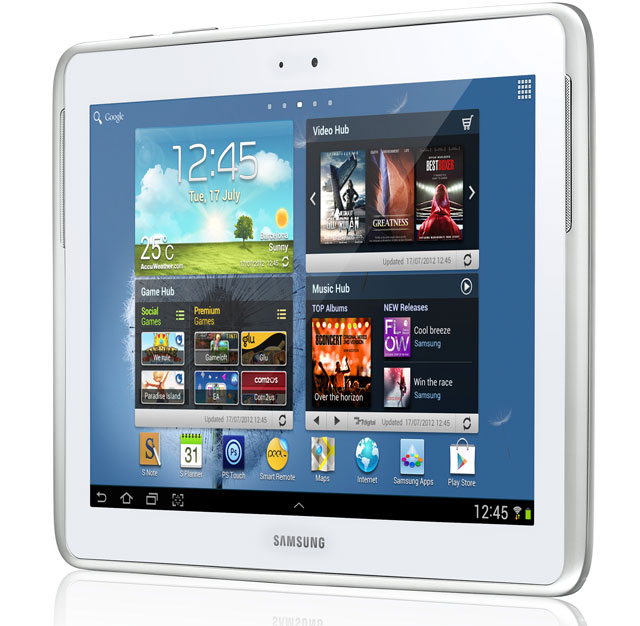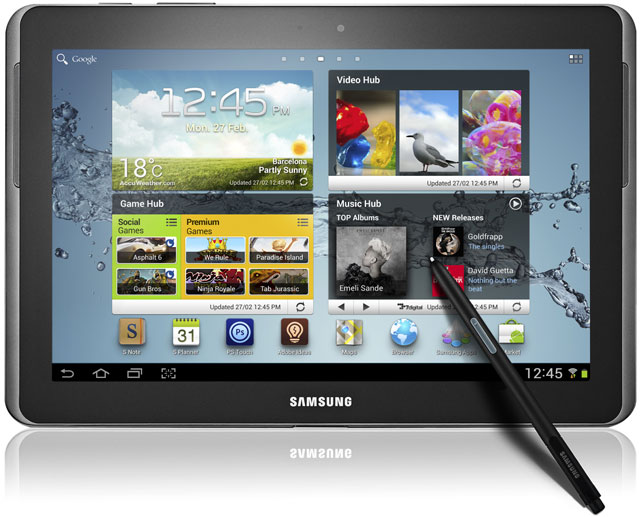
After Samsung Electronics’ incredible Galaxy S3 smartphone, we had high hopes for the Korean company’s latest tablet offering, the Android-powered Galaxy Note 10.1.
Unfortunately, it was not to be. Although the Note 10.1 has a few standout features — the stereo front-facing speaker system is one of them — the tablet doesn’t achieve what is has to, namely provide users with an experience that at least matches the best Apple has to offer.
But let’s start with the good. What Sammy has done right with the Note 10.1 is pack in some powerful innards, including a quad-core, 1,4GHz Exynos 4 processor and 2GB of RAM. The 7 000mAh battery is also good, delivering a battery life of up to eight hours with continuous use. That’s not quite as good as the iPad, but it’s respectable nonetheless.
The powerful processor and extra RAM mean, for the most part, a silky smooth experience while navigating around Android. We did notice occasional slight lag when we had too many active widgets open on one screen, but nothing that would be a deal breaker for consumers.
The Note 10.1 comes equipped with a choice of 16GB, 32GB or 64GB of flash storage — the former two are more than enough unless you want to carry large amounts of music or video on your tablet — and comes in Wi-Fi-only and Wi-Fi and 3G versions. The 3G in question is HSPA+ at 21Mbit/s; the Wi-Fi includes the speedy “n” variant. There’s the standard accelerometer, gyroscope, digital compass and GPS (assisted in the case of the 3G version).
The weight of the device is also pleasing: 600g for the 3G version and 3g less than that for Wi-Fi-only Note 10.1. That’s more than 50g less than the third-generation iPad, enough to make the difference noticeable. Score one to Samsung.
Another feature in the Note 10.1’s favour is its integrated microSD slot, which accepts cards up to 64GB in size — great for storing photos and multimedia files without cramping the device’s internal storage. The microSD slot is complemented along the top of the Note 10.1’s bezel by an on/off/wake button, volume rocker, infrared port that can be used to control a television, and a full-sized Sim card slot.

The tablet has a bog-standard 5-megapixel rear-facing camera that takes, err, bog-standard pictures. The front of the device is equipped with a 1,9-megapixel shooter for video calling and vanity shots.
The standout feature of the Note 10.1 — the one Samsung no doubt hopes will sway consumers to purchase its product over the iPad — is the inclusion of a stylus, the “S Pen”. When you pull this pen out of its holder on the right-hand side of the tablet, a menu of helpful applications optimised for use with the pen pops up on screen. The menu can be customised and set, for example, to open a specific app when you pull out the pen.
The apps that have been optimised for use with the pen are S Note (note-taking app), Photoshop Touch (an image touch-up program), Crayon Physics (for the kids), Polaris Office (a basic productivity suite) and S Planner (calendaring). Although it’s fun using the S Pen to scribble down a few notes and e-mail them off, we’re not convinced users will really find everyday uses for it. Fingers remain the most intuitive means of navigating around touch screens. Oh, and be warned, it’s really easy, as we discovered, to insert the pen incorrectly into its holder and to get it jammed there.
Perhaps creative types will find a use for that pen, but the question is: will they be able to overlook the 10,1-inch screen, which, at 1 280×800 pixels, is run-of-the-mill at best and noticeably poor next to the new iPad. To keep costs down, Samsung has foregone a higher-resolution screen that would have made this tablet stand up much better against its main rival.
Unfortunately, the decision to opt for a relatively low-resolution screen ultimately makes it impossible to recommend the Note 10.1 over the new iPad. Apple has set the new benchmark that has to be met. That Samsung is a world leader in display panel technology makes its decision even stranger.
The Note 10.1 has one other big flaw, and that’s its build quality. The rear of the device, in particular, feels plasticky and cheap. Yes, the same is true of the Galaxy S3, but in the case of the 10.1, the cheapness is amplified because of the tablet’s size.
The last problem with the tablet — and it’s not a problem of Samsung’s making — is that Android still doesn’t feel as refined as it could be on screens this size. The Google operating system works great on smartphones and arguably even on 7-inch tablets but still has a clunkiness about it on large-format tablets. Perhaps Jelly Bean, the latest iteration of Android, will resolve many of these issues.
All in all, it’s hard to recommend the Samsung Galaxy Note 10.1. Don’t get us wrong, it’s a good tablet with powerful hardware but is let down by poor build quality and the screen.
The simple fact is that the Note 10.1 is not as good as the latest iPad, and the integrated stylus doesn’t offer enough that’s different to sway us in Samsung’s direction. — (c) 2012 NewsCentral Media
- TechCentral reviewed the 32GB Wi-Fi and 3G model, which has a recommended retail price of R8 499. We are awaiting pricing on the other models and will provide this information when we’ve received it.




